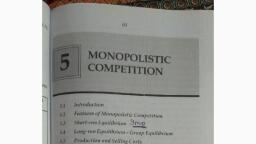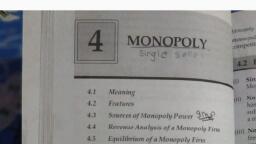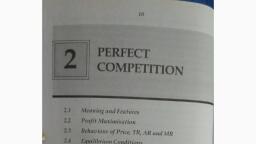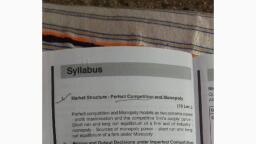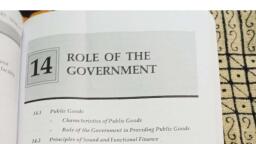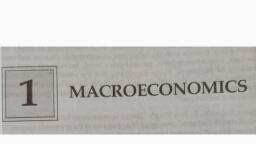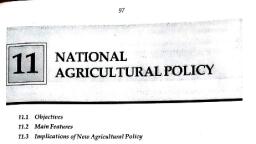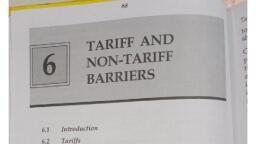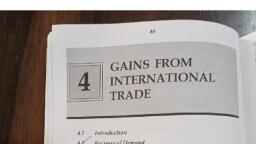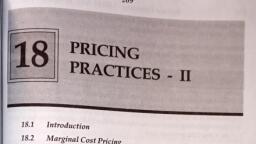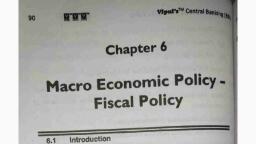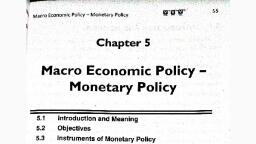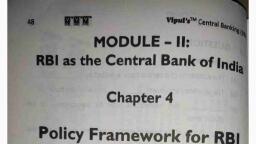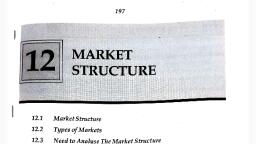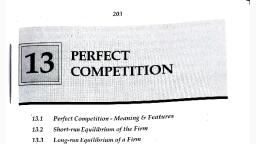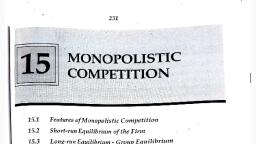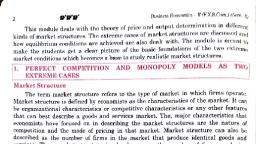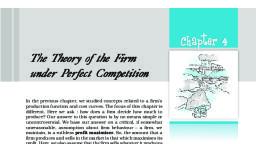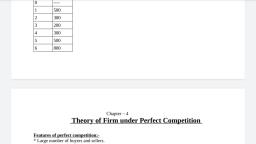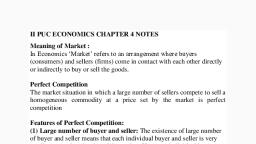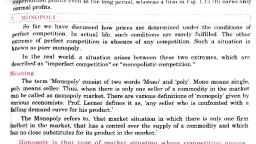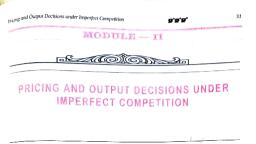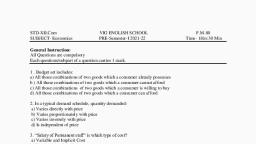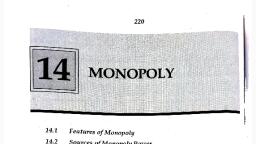Page 1 :
203, , | PERFECT, COMPETITION —, , , , , , , , ‘13.1 Perfect Competition - Meaning & Features, 13.2 Short-run Equilibrium of the Firm, , 13.3. Long-run Equilibrium of a Firm, 13.4 Equilibrium of Industry and Firm, , ————— SS ee, , ING AND FEATURES, , SS, , , , Earlier, we have discussed the consumers’ behaviour, demand analysis,, cost and production. Commodities produced are to be sold in the, commodity or product market. Price of a product is determined by, aggregate demand and supply. The importance of a producer in influencing, the price depends on the type of market that he is in. The market structure, of an economy comprises perfect competition, monopoly, monopolistic, competition, oligopoly and duopoly. Depending on the type of market a, producer may be a price taker, price maker or price discriminator. A, producer may be a follower or a leader., , Let us discuss the price determination and equilibrium of the firm and, _industry under perfect competition. It is therefore necessary to explain the, concept of perfect competition., , A market becomes perfectly competitive when the following conditions, exist., , (i) A Large Number of Buyers and Sellers : Both buyers and sellers are, in a large number, so that individually neither buyer nor seller is ina
Page 2 :
204, , (ii), , (iii), , (iv), , (v), , (vi), , Business Economics - I (BMS, BAF, BFM, BBI.: SEM - }), , Position to influence the price. Influence of an individual buyer o,, seller is absolutely insignificant. They will have to accept the price, established in the market, A single seller cannot increase the price. |f, he does he will not get buyers. The buyer cannot bargain for a lowe,, price, as there are enough buyers at the prevailing price., , Homogeneous Commodity : A commodity sold in the market is, homogeneous, that is, identical in quality and quantity. A difference, of any type would provide an excuse for the sellers to charge a higher, Price. When goods are homogeneous there is no possibility of charging, a higher price by any seller under the pretext of qualitative or, quantitative difference., , Free Entry and Exit.: There is no restriction whatsoever for any, producer to produce a commodity and sell it in the market. Restriction, may be in the form of Government's license or permit, non-availability, of technology, inadequate finance etc. Similarly a producer is free to, wind up his business without any problems, legal or political. Such, freedom avoids excess supply or shortages., , Complete Market Information : A perfect knowledge or complete, information about the market - price, demand, supply etc. is expected, to be possessed by all the buyers and sellers. Such knowledge will, prevent the buyers from paying a higher price and sellers charging a, different price than what is prevailing in the market., , Perfect Mobility of Factors of Production : Factors of production are, assumed to be freely mobile geographically and occupationally. It, mainly applies to labour and capital. Perfect mobility helps diverting, , the factors to those areas where there is more demand from the one |, , where demand is deficient. It helps adjust supply according to, demand. —, , No Transport Cost : Factors of production and goods are transported, from the place of production to the market without any cost. Transport, cost does not arise if we take small geographical areas where, production and sale takes place within that area. Agricultural products, can be sold in the same village or town without incurring much, transport cost. This condition is assumed to avoid any possibility of, charging a higher price on the pretext of transport cost., , Under the above conditions, for a particular commodity there can be only, asingle uniform price throughout the market., , A distinction is usually made between pure and perfect competition. Of, the six conditions mentioned above the first three conditions make the
Page 3 :
205, , Perfect Competition, s more, , competition pure and all six conditions make it perfect. The latter }, restrictive market than the former., , e total demand and, or producer has to, in Fig 13.1 Aand, , Price under perfect competition is determined by th, total supply in the market. An individual consumer, accept the price determined in the market. It is explained, B., , Y¢ YA, , Price, , , , , , , , , , > >, ° Q x o Quantity xX, Quantity demanded & supplied Fig, 13.1 (B), Fig. 13.1 (A) : Market Single Buyer and Seller, , Price is determined by the intersection of market demand and market, supply curves as shownin Figure 13.1A. Price thus determined is accepted, by the individual consumer and seller. They can purchase or sell any, amount of that commodity at the prevailing price. The horizontal line in, Figure 13.1B shows the price to be charged and paid by the individual, seller and buyer. In perfect competition a seller is a price taker., , , , , , A. EQUILIBRIUM CONDITIONS, , A firm applies the principles of marginal cost (MC) and marginal revenue, (MR) while deciding to produce its output. We have discussed the meaning, and behaviour of marginal cost in chapter 9., , In diagram 13.1 (B), we have explained how an individual firm accepts its, price determined in the market by aggregate demand and supply. At that, price (per unit) a firm can sell all that it wants to sell. The price line here is, a straight horizontal one. In perfect competition we can obtain a firm's, average revenue (AR) by PX Q= TR/Q= AR, that is
Page 4 :
206 Business Economics - I (BMS, BAF, BFM, BBI.: SEM- }), TR :, PxQ = —=AR, Q, , -. P=AR, , Here price line and average revenue line are identical. Marginal (MR) is, equal to ATR, that is a change in TR. Since the firm sells the total quantity, for the same price per unit, it is a change in TR (ATR) which is equal to P,, Since P = AR. A change in TR (ATR/Q) is MR, hence P = AR = MR., , Bringing MC and MR together, we can decide the equilibrium output of a, firm in perfect competition as shown in Fig. 13.2., , “Y4, , , , AR=MR, , Price, , , , , , , , , , > X, , °, 1D fe eneeneneeneee, 2 oon en, , Output “, Fig. 13.2, , In Fig. 13.2, marginal cost declines as production increases and starts, increasing after a certain level of production. It cuts MR at two points E, and E,. At E, MC cuts MR from above whereas at E, it cuts MR from below., , The firm cannot stop its production at E, as the marginal cost till that point, is higher than marginal revenue resulting in loss. From point E to E,,, marginal cost is lower than marginal revenue bringing more revenue than, cost. Therefore to maximise profit the firm must produce upto the point, where (i) MC = MR and (ii) MC must cut MR from below or MC at the, point of equilibrium must be increasing. ,, , When the above two conditions are fulfilled, the firm's output is at, equlibrium point., , We analyse the equilibrium of the firm with the help of the following, , | . assumptions :, , (i) The firm is rational ice. it tries to maximise profit., , meAaPRAdcRS BF, , en a
Page 5 :
iti 07, perfect Competition 2, , a) Perfect competition in product market., ws . s i ies, Perfect competition in factor market. This assumption impli, , iii), identical cost of production to all the firms., , (iv) The firm operates under U shape cost curve., , (v) Price of the product is determined by the aggregate demand and, , aggregate supply., , (vi) The firm is a price taker., , p. SHORT-RUN EQUILIBRIUM OF A FIRM, , We are familiar with the concept of short-run as discussed under the bash, analysis. In the short run there is a distinction between fixed cost an, variable cost. The firm operates within the given cost structure and capacity., The number of firms in the market remains constant. There is no entry or, exit from the market. The price is determined in the market by demand for, and supply of industry's output. The price thus determined is accepted by, the firm, turning the firm into a price taker. Given the price, demand and, cost, the rational firm aiming at maximisation of profit produces output, upto the point of equilibrium ie. MC = MR and MC is increasing at the, point of equilibrium., , Afirm being in equilibrium does not necessarily earn profit. It only means, the firm observes the equilibrium rules to determine its output and sells it, atthe prevailing price. By doing so the firm may earn excess profit, normal, profit or even may incur loss. Figure 13.3 explains these three possibilities, that a firm may face in the short-run., , , , , , Price, , , , ZY., o, , , , , , , , , , 0 @ 1 Q »X, , Output, Fig. 13.3
